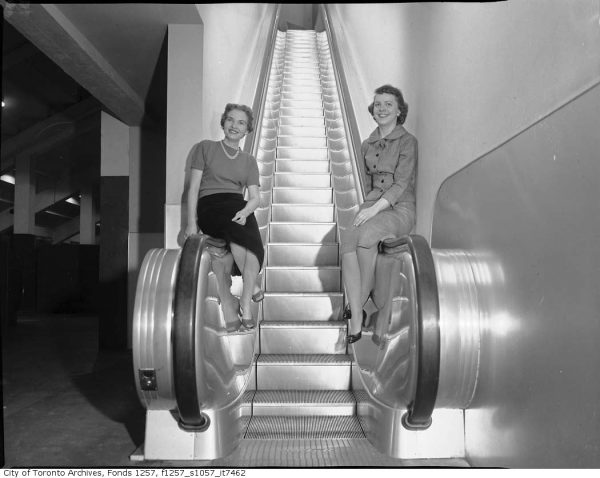When Spacing asked Torontonians for their insights into Toronto public etiquette, one of the clearest and most repeated messages we got was, when on an escalator, stand right, walk left. As one of our readers put it, “Stand Right; Walk Left. That’s all we need to keep things orderly.”
It seems pretty straightforward, and has probably been a rule since the dawn of escalators. But recently, that rule has come under fire. The London Underground is (*gasp*) asking their customers to stand on both sides of the escalator at some stations. It’s an idea so counter-intuitive that the Underground at one point deployed a hologram to encourage people to change their habits. Other transit agencies worldwide are moving in the same direction. This controversial new idea is based on mathematics — on a long escalator, where fewer people will want to walk, the escalator’s capacity is in fact much higher if both sides are used for standing, rather than the left side being reserved for a small number of hardy climbers. As well, if used disproportionately, the right side of the escalator apparently suffers extra damage, leading to a need for more maintenance.
I saw this algorithm in action myself on a visit to Moscow a few years ago. The Moscow subway is very deep (it was designed to double as a bomb shelter) and its escalators are forbiddingly long. But many people still observe the classic rule, so at the bottom of escalators at busy times, there was sometimes a crowd backed up waiting to get on the right side of the escalator, while the left side remained underused.
In Toronto, few of the TTC’s escalators reach a height that will discourage most people from walking (the Underground estimated the tipping point to be higher than 18.5 meters). But you still won’t see the classic escalator rule in the TTC’s new etiquette campaign. The TTC removed its “Stand right, walk left” signs about a decade ago, and is officially encouraging people to always stand on escalators. Its reasons are different — to reduce accidents. The agency says that the non-standard size of escalator steps results in a disproportionate number of trips, slips and falls. Transit agencies in Hong Kong and Japan have made similar moves.
But escalator etiquette is deeply ingrained. In all places where transit agencies have tried to change this behaviour, they have encountered deep resistance from riders. Toronto is no different — Torontonians have been very clear on how they expect people to behave on escalators.
That’s why, in our about-to-be-launched Toronto Public Etiquette Guide, we conclude that, when it comes to the stand right, walk left rule, the TTC may have removed the signs but, “Be that as it may, Torontonians still expect this behaviour — the signs may have come down, but the rule, unspoken, is still in place.”
The Toronto Public Etiquette Guide will be launched on May 11, 2017.
Image courtesy of the City of Toronto Archives







7 comments
I suspect the biggest issue here is that everyone expects one step to themselves, as opposed to standing next to a stranger. Personal space boundaries. But it’s hard to think of any other infrastructure that we so adamantly use only half of its capacity!
Escalators aren’t stairs. Don’t walk on the damn escalator.
Underrated fun: stand by a busy escalator sometime for ten minutes and watch how many walkers trip on the escalator. It’s a lot, because the rise and run of escalator platforms is usually quite different to stairs.
In case that the escalators stop moving, call 9-1-1. Do not walk. Do not move. Wait for emergency response.
Heh. In Tokyo a few years ago they were really pushing the “don’t walk on the escalator” thing. But it was also very engraned that one should “walk left, stand right”.
Therefore, most escalators had *no one* on the left, as that is where you walk, not stand. But you should not walk, so….
Very interesting. Not mentioned is a study on the length of escalators typical to the TTC subway. The original study (two major recent ones actually, both University) has put a number of provisos on their claim. The TTC overlooks that.
Folks, I can guarantee you, if you have a moving left side cadre of escalator climbers passing a static right side one, the moving ones will not only get to the top faster, but the “throughput” will increase, a number of provisos applying, but ones that also equally apply to the static standees. (Space needed to embark, disembark, etc).
There’s a reason you see people sprint past you on the left. The same reason you take the fast lane on the highway. Think about it.
‘Are you kidding’ writes:
[Underrated fun: stand by a busy escalator sometime for ten minutes and watch how many walkers trip on the escalator. It’s a lot, because the rise and run of escalator platforms is usually quite different to stairs.] And those folks are the ones who should stand to the right. That’s already been factored into the algorithm.
Same could be said for eliminating steps altogether for ramps. It does not follow that by eliminating all steps and providing ramps instead will increase the throughput or reduce time to travel, quite the contrary.
One thing to say: An escalator is an aid to human movement, not a replacement for it. Pick up your lazy feet and walk.